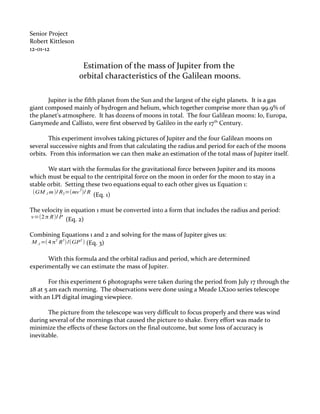
Senior_Project_Robert_Kittleson
- 1. Senior Project Robert Kittleson 12-01-12 Estimation of the mass of Jupiter from the orbital characteristics of the Galilean moons. Jupiter is the fifth planet from the Sun and the largest of the eight planets. It is a gas giant composed mainly of hydrogen and helium, which together comprise more than 99.9% of the planet's atmosphere. It has dozens of moons in total. The four Galilean moons: Io, Europa, Ganymede and Callisto, were first observed by Galileo in the early 17th Century. This experiment involves taking pictures of Jupiter and the four Galilean moons on several successive nights and from that calculating the radius and period for each of the moons orbits. From this information we can then make an estimation of the total mass of Jupiter itself. We start with the formulas for the gravitational force between Jupiter and its moons which must be equal to the centripital force on the moon in order for the moon to stay in a stable orbit. Setting these two equations equal to each other gives us Equation 1: (GM J m)/ R2=(mv 2 )/ R (Eq. 1) The velocity in equation 1 must be converted into a form that includes the radius and period: v=(2π R)/ P (Eq. 2) Combining Equations 1 and 2 and solving for the mass of Jupiter gives us: M J =(4π2 R3 )/(GP2 ) (Eq. 3) With this formula and the orbital radius and period, which are determined experimentally we can estimate the mass of Jupiter. For this experiment 6 photographs were taken during the period from July 17 through the 28 at 5 am each morning. The observations were done using a Meade LX200 series telescope with an LPI digital imaging viewpiece. The picture from the telescope was very difficult to focus properly and there was wind during several of the mornings that caused the picture to shake. Every effort was made to minimize the effects of these factors on the final outcome, but some loss of accuracy is inevitable.
- 2. Picture #1 : 7-17-12 , No clouds. Picture #2 : 7-19-12 , No clouds, light wind. Picture #3 : 7-23-12 , No clouds.
- 3. Picture #4 : 7-26-12, No clouds, light wind. Picture #5 : 7-27-12 , No clouds. Picture #6 : 7-28-12 , No clouds, high wind.
- 4. The distance from the center of Jupiter and each moon was measured in pixels and used to calculate their orbital radius and angular frequency in Mathematica. (see Appendix A) In order to convert the pixels to kilometers I used the known equatorial diameter of Jupiter and compared that to the measured diameter of Jupiter in each picture to arrive at a value of 1.56 x 106 km per pixel. Multiplying this conversion factor by the orbital radius in pixels and converting the angular frequency into the period in days we arrive at the values required. (see Appendix B) Now we can calculate the mass of Jupiter for each of the four moons orbits. Io: 1.096 x 1027 ± 2.027 x 1025 kg Europa: 7.762 x 1026 ± 7.966 x 1024 kg Ganymede: 1.154 x 1027 ± 7.384 x 1024 kg Callisto: 1.200 x 1027 ± 2.035 x 1026 kg Averaging these gives a value of 1.057 x 1027 ± 2.035 x 1026 kg for the mass of Jupiter. Comparing this to the known mass of 1.90 x 1027 kg gives us an error of 44%. Since the data from each of the moons was on the low side by about the same percent, I suspect that there was a systemic error somewhere in the measurements, probably the result of my inability to obtain a clear, focused picture from the telescope.
- 5. Appendix A – Mathematica Notebook The time (in days) and the distance of each moon from the center of Jupiter (in pixels). DataTableIo = {{0,212.28},{2,177.07},{6,-159.00},{9,209.16},{10,-171.94},{11,96.17}}; DataTableEuropa = {{0,48.00},{2,-143.20},{6,130.38},{9,-214.58},{10,325.96},{11,75.59}}; DataTableGanymede = {{0,-550.56},{2,-67.08},{6,-163.99},{9,-160.03},{10,323.18},{11,573.58}}; DataTableCallisto = {{0,-132.97},{2,-764.55},{6,-701.59},{9,346.98},{10,665.59},{11,907.80}}; Mathematica code for determining orbital radius, a; and angular frequency, w. fitI = FindFit[DataTableIo,{a Cos[w t+b],{a>0,3.5<w<3.6}},{a,w,b},t] {a225.47, w3.54958, b-4084.26} fitE = FindFit[DataTableEuropa,{a Cos[w t+b],{a>0,1.7<w<1.8}},{a,w,b},t] {a324.504, w1.72825, b-1915.28} fitG = FindFit[DataTableGanymede,{a Cos[w t+b],{a>0,.8<w<.9}},{a,w,b},t] {a579.029, w0.885256, b6355.07} fitC = FindFit[DataTableCallisto,{a Cos[w t+b],{a>0,.3<w<.4}},{a,w,b},t] {a1036.9, w0.376661, b12379.5} Plots of each planets orbital characteristics. X-axis is time in days, Y-axis is distance in pixels. Show[Plot[a Cos[w t+b]/.fitI,{t,0,12}],ListPlot[DataTableIo,PlotRangeAll]] 2 4 6 8 1 0 1 2 2 0 0 1 0 0 1 0 0 2 0 0
- 6. Show[Plot[a Cos[w t+b]/.fitE,{t,0,12}],ListPlot[DataTableEuropa,PlotRangeAll]] 2 4 6 8 1 0 1 2 3 0 0 2 0 0 1 0 0 1 0 0 2 0 0 3 0 0 Show[Plot[a Cos[w t+b]/.fitG,{t,0,12}],ListPlot[DataTableGanymede,PlotRangeAll]] 2 4 6 8 1 0 1 2 6 0 0 4 0 0 2 0 0 2 0 0 4 0 0 6 0 0 Show[Plot[a Cos[w t+b]/.fitC,{t,0,12}],ListPlot[DataTableCallisto,PlotRangeAll]] 2 4 6 8 1 0 1 2 1 0 0 0 5 0 0 5 0 0 1 0 0 0
- 7. Appendix B – Table of measurements Moon Orbital Radius(Pixels) Orbital Radius(km) Orbital Period(days) Io 226 ± 1 3.512 x 105 ± 1.5 x 103 1.77 ± 0.005 Europa 325 ± 1 5.062 x 105 ± 1.5 x 103 3.64 ± 0.005 Ganymede 579 ± 1 9.018 x 105 ± 1.5 x 103 7.10 ± 0.005 Callisto 1037 ± 1 1.615 x 106 ± 1.5 x 103 16.68 ± 0.005 07/17/12 07/19/12 07/23/12 07/26/12 07/27/12 07/28/12 Jupiter Diameter (pixels) 97 90 112 – discarded as outlier 96 94 82
- 8. References Chaisson, Eric; McMillan, Steve; Astronomy: A Beginners Guide to the Universe; Prentice-Hall: 1995 Knight, Randall D.; Physics for Scientists and Engineers; Addison Wesley: 2004 Jet Propulsion Laboratory (2011, Dec. 14); Planetary Satellite Mean Orbital Parameters http://ssd.jpl.nasa.gov/?sat_elem